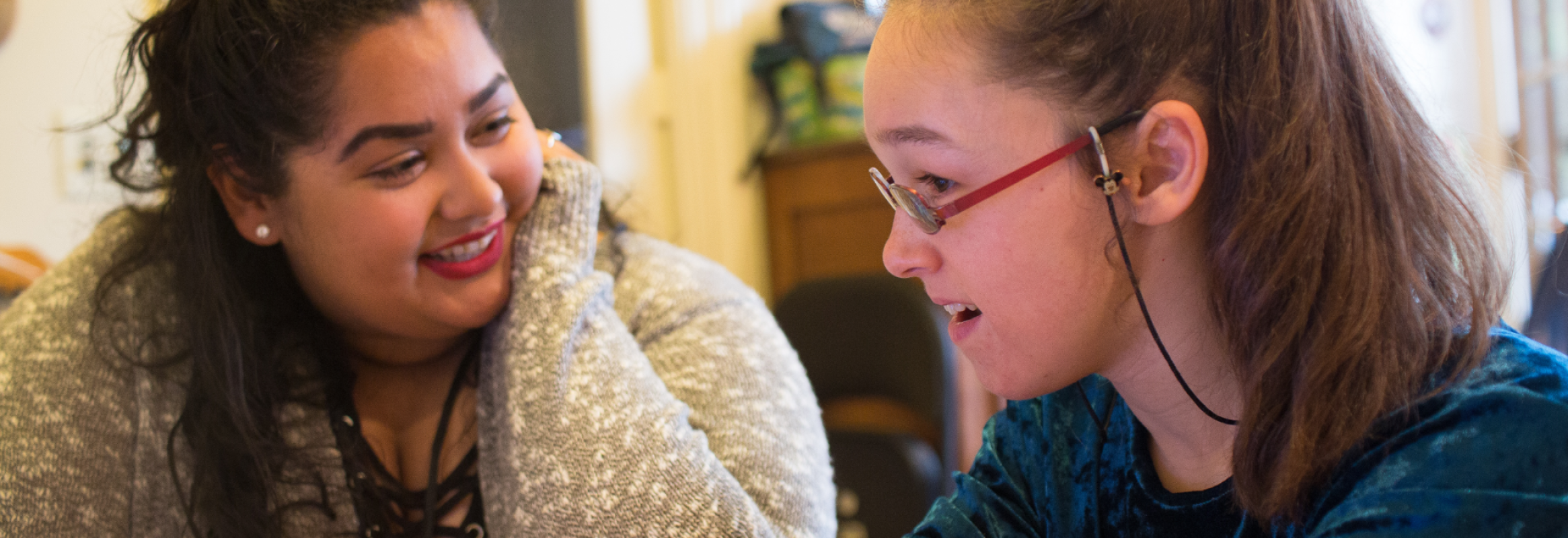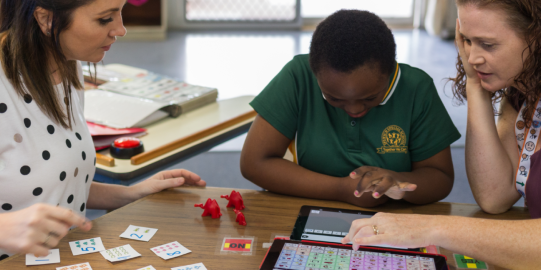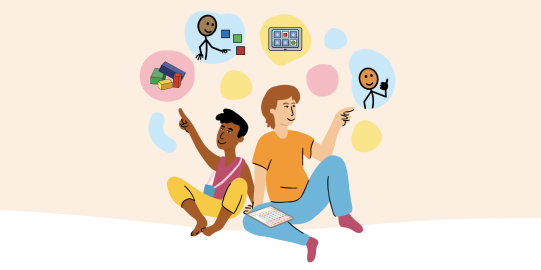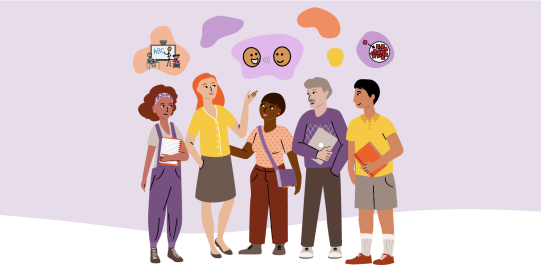Teamwork is the key to successful AAC! AAC users, parents, and professionals working together towards shared communication goals are wonderful. What happens when a member of the team is limiting language? What do you do when someone is not following best practices in AAC implementation? These situations can make working as a team difficult and impede collaboration. So let’s focus on how to overcome these roadblocks collaboratively.
Five common reasons AAC teams aren’t on the same page
1. They can’t agree on the best AAC tool
Everyone needs a way to communicate. They must be able to express themselves at all times and across all settings. We believe everyone needs access to a “robust” AAC system. A system with many words and access to the alphabet so AAC users can learn to say anything to anyone at any time.
But when deciding the best AAC tool and grid size for an AAC user, teams often do not agree.
There are many reasons why a member of the AAC team might be reluctant to get on board with a robust AAC system. Often it is because that person has a different problem they are trying to solve or a different goal in mind.
For example:
- The teacher might only be focused on teaching particular vocabulary words so that the AAC user can access the curriculum.
- The behavior therapist might think the problem is that the AAC user has challenging behaviors, from not being able to get what they want and just focusing on requesting.
- The family is working towards building connections and friendships and wants their child to have all the words.
So before any decisions can be made, AAC teams need to agree on the AAC tool and grid size together.
Generally, if a person cannot rely on speech, they will likely need a balanced and robust AAC tool. Getting teams to agree to and use this tool can sometimes feel like a battle.
Please also know that using multiple AAC tools and strategies is possible. There are other ways to grow and develop communication for a nonspeaking person to use in combination with a robust AAC system.
Here are some examples:
- If they need support with storytelling, using photos from their camera reel might be helpful.
- Supported decision-making can be aided with strategies like Talking Mats and decision-making agreements.
- The AAC user can use social media to help build friendships.
- Visual supports, like visual schedules, can also help in certain situations.
- Learning to support and accept all other communication, including vocalizations, gestures, head nods/shakes, and signing, is also important.
All of this together makes up the complete AAC package with a range of AAC tools and strategies that work best for your situation.
2. Someone believes the AAC user “isn’t ready”
The world of AAC has changed dramatically since AAC apps could be accessed on tablets. We now know that there are no prerequisite skills for AAC. AAC users don’t need to start with “beginner AAC” or prove anything before having access to a robust AAC system.
Unfortunately, some old ways of practice can still linger, and attitudes can be hard to shift. So what can you do if that is happening in your AAC team? Educate and inspire!
The research on AAC is clear- Robust is best! Share research, articles, and blog posts with the team. Listen to and learn from the voices of AAC users. They are the experts in AAC! Tell stories about AAC being used, share videos, and celebrate success. Let’s get everyone on the team motivated and excited about the AAC journey ahead. The nonspeaking person is ready, and the time to start is now!
3. Team members are using restrictive practices
Anytime someone limits, restricts, or controls AAC and its unlimited use, we call that “restrictive practice.” These restrictive practices are not generally done to harm the AAC user intentionally. But restrictive practice can cause harm and limit the language and communication of a nonspeaking person.
A common example we hear is that a member of the AAC team is hiding buttons, deleting buttons, or changing the grid size to have fewer buttons on a page.
Here are some common reasons:
- They believe the AAC user “isn’t ready.”
- They think they are making it easier for the AAC user.
- They only want the AAC user to point to certain things (like answers to questions).
- They are overwhelmed and don’t feel confident modeling on the device yet.
- They say the AAC is too confusing for the AAC user.
Whatever the reason, once we find out why the team member wants language restricted, it allows us to ask questions and start conversations. Offer support to the team member.
For example, the person who believes the AAC user isn’t ready might need information on believing in a person’s ability to communicate and learn. The person who feels overwhelmed modeling might need step-by-step guidance and support.
There may be situations when observing what the AAC user can already do is a valuable strategy. When someone says, “They can’t handle small buttons,” then spend some time watching them. Can they open and close apps on an iPad? Navigate YouTube? If they can do these things, then they can handle small buttons. Use these observations to start the conversation within the team.
Another common restrictive practice is physical prompting or hand-over-hand support. This is when people take a person’s hand to help them or make them point to words on their AAC device. Physical prompting should be avoided. Modeling AAC is more effective than physical prompting and is a practice that protects nonspeaking people.
4. AAC modeling is not being done consistently
We often ask all members of our AAC team to go out and model. That may seem easy for some. But we know from experience that modeling is hard. People do it in different ways. People are often inconsistent with how, what, and when they model.
Without consistent and responsive modeling, a nonspeaking person can never really learn to use their AAC. Even worse, when the person does not start using the AAC as hoped, the tool and person can be blamed! Very rarely does someone blame a lack of modeling. Teams disagree about the AAC tool being used. Or teams look at the nonspeaking person and think they are not capable of using AAC. In most cases, AAC fails because modeling is not being done consistently.
Making a modeling plan is the best way to get modeling happening consistently.
Download modeling plan template
Agree on what will and will not be done. Stick to the plan for a determined amount of time. Take photos and videos of the team modeling so that you can review and reflect on the modeling being done. Stay consistent in what you model and how you respond to the AAC user. Team members can learn from seeing each other model. The AAC user will flourish with a team that is on the same page and modeling consistently.
5. The AAC user is not involved
While all this planning and conversations are happening about an individual, their needs, and goals, has anyone on your AAC team ever stopped and asked - what do they think? The AAC user is the center of the AAC team and has the right to have goals and strategies explained to them in terms they can understand. All members of the AAC team need to find ways to include and involve the AAC user in decisions that affect their life. Avoid assuming that the parents and professionals know what is best!
In practical terms, invite an AAC user to attend the meetings. Take time before meetings to explain the purpose and reason for the meeting so they can prepare. If it is not possible for the AAC user to attend, asking a trusted adult to talk to them before the meeting and advocate on their behalf is important.
There are always ways to ask AAC users about their opinions and preferences. What they like. How they want to be supported. What ideas do they have for the future? Don’t assume; ask!
Nothing is perfect
No matter how well your AAC team is going, there will always be hiccups. New team members start. Something medical happens. Identify those barriers and problems as soon as they happen. Always reflect on what is working and what is not. Face these things together with your team. Together you can solve them.
Get started today
Start big and important conversations with your AAC team. With shared knowledge and understanding, you can make some of that AAC magic! So, decide together, plan together, then stick to the plan!





